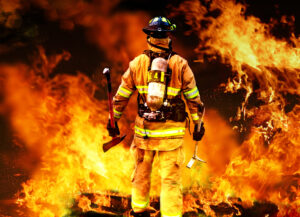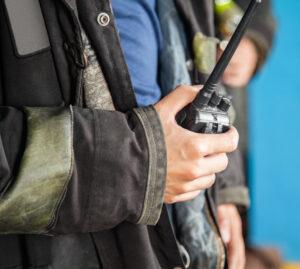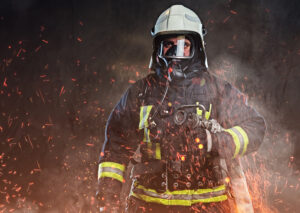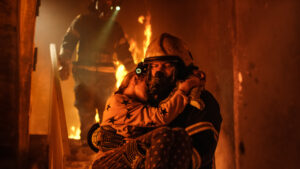Public Safety DAS Code Requirements

In emergency situations, such as natural disasters, fires and medical emergencies, first responders rely heavily on emergency radio systems to effectively respond. Public Safety DAS (Distributed Antenna System) is a public safety communication system that allows first responders to maintain wireless communication within buildings. Public Safety DAS works by utilizing a Bidirectional Amplifier (BDA) system in buildings that brings the wireless signal into structures from the outside.
Public Safety DAS is mandatory and is an important tool that ensures the safety of emergency responders, such as Firefighters, Police Officers and Emergency Medical Service Responders. Public Safety DAS gives radio signals the ability to access areas in buildings such as elevators, stairwells, basements and parking garages, and ensures communication without interference.
Building Code Requirements
Public Safety DAS is jurisdiction based, the code requirements governing your area is determined by the location of your building. Counties and cities develop code requirements for public safety communication systems based on codes issued by the National Fire Protection Association (NFPA) and the International Code Council (ICC). Many Cities and Counties in the United States have enacted ordinances that require buildings to meet a minimum standard for all public safety communication systems. Public Safety DAS applies to the following structures:
Office Buildings and High Rises
Hotels and Hospitality Venues
Airports and Train Stations
Stadiums and Arenas
Campuses and Malls
Parking Structures and Storage Facilities
Public Safety DAS and Florida Fire Prevention Code
Florida State recently passed the updated Public Safety DAS compliance and testing mandates that counties and cities in Florida are required to adhere to. The Florida Fire Prevention Code, which is based on codes issued by the NFPA and the ICC specifies that the local fire code official (AHJ) shall determine the minimum radio signal strength for fire department communications in all new and existing high-rise buildings.
Existing buildings are required to comply with minimum radio strength for fire department communications and two-way radio system enhancement communications (Public Safety DAS) by January 1, 2025. By January 1, 2024, an existing building that is not in compliance with the requirements for minimum radio strength for Public Safety DAS systems must apply for the appropriate permit for the required installation with the local government agency for your jurisdiction and must demonstrate that the building will become compliant by January 1, 2025.
What are Public Safety DAS Requirements?
Public Safety DAS provides first responders with a reliable communication system that operates between different emergency and governmental entities. And allows for the secure transmission of essential information that can save the lives of first responders and the public. Public Safety DAS is essential in ensuring that first responders have a reliable public safety communication system in order to effectively respond to emergency situations. First responders must be able to communicate instantly, without interference and must be able to transmit and receive sensitive information securely.
Public Safety DAS Wireless Coverage Requirements
The NFPA dictates that areas deemed as critical or of “vital importance”, requires 99% coverage. Areas such as fire command centers, the fire pump room, sprinkler valve locations, exit stairs, exit passageways, elevator lobbies or any other areas as specified by the AHJ. In all other areas, the NFPA requires 90% coverage.
Public Safety DAS Minimum Signal Strength Requirement
The minimum signal strength must be sufficient to provide voice communication throughout the coverage area. Inbound and outbound signal strength set by the IFC and the NFPA require a minimum signal strength of -95 dBm for adequate coverage.
Public Safety DAS Battery Backup Requirement
Maintaining power is an essential part of ensuring that public safety communication systems are always operable, therefore a secondary power source is required. The IFC requires that emergency radio coverage systems (public safety communication systems) be provided with dedicated standby batteries or provided with 2-hour standby batteries and connected to the facilities generator power system. The standby power supply shall be capable of operating the emergency radio coverage system at 100% capacity for a minimum of 12 hours.
Radio Equipment Enclosures Requirement
It is very important that sensitive equipment is protected from water damage and is able to function properly. The IFC and NFPA stipulates that all equipment supporting the public safety network must be contained in NEMA-4 compliant enclosures. The National Electrical Manufacturer Association (NEMA) requires that all communication equipment be contained in a 4-type waterproof cabinet.
Antenna Isolation Requirement
Public Safety Communication Systems must operate without interference, therefore the NFPA and the IFC dictates that antenna isolation must be 20 dB or higher than the gain under all operating conditions.
Public Safety DAS Testing Requirements
It is the building owner’s responsibility to have their public safety communication systems inspected and tested annually. Testing and inspection is also required when there are structural changes, including additions or remodels that could significantly change the original field performance test. Buildings must be tested by a certified Public Safety DAS professional and property owners must ensure that buildings meet all the required standards.
Building Owners Responsibility
Building owners must have a clear understanding of the Public Safety DAS code requirements that govern their area, as different jurisdictions have different requirements. The International Code Council (ICC) and the National Fire Protection Association (NFPA) set the model code requirements at the national level. Codes issued by the ICC and the NFPA include, the National Fire Code, the National Electrical Code (NEC), the International Fire Code (IFC) and the International Building Code (IBC). Cities and Counties have adopted their versions of the code requirements based off codes issued by these entities.
Ensuring that buildings are compliant of Public Safety DAS code requirements is a legal obligation. Ensuring compliance can be a lengthy process that requires rigorously testing by a certified Public Safety DAS professional. An appropriate Public Safety DAS provider will measure the current signal strength in your building to determine what steps need to be taken to ensure compliance. It is the building owner’s responsibility to ensure that buildings are compliant of Public Safety DAS codes and regulations and that buildings can support current and future public safety communication frequencies.



